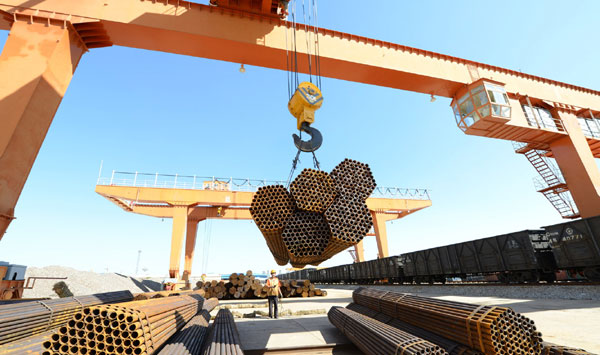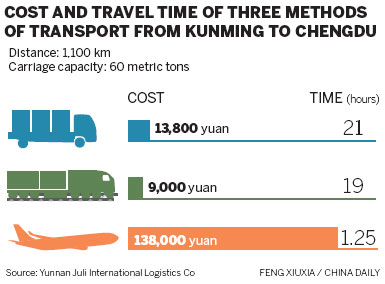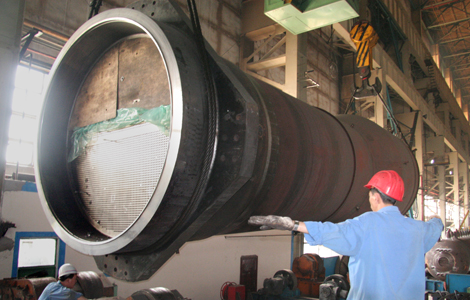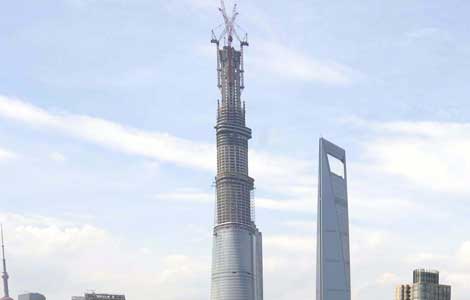Getting freight traffic back on the rails
Updated: 2013-08-08 07:58
By Hu Yongqi (China Daily)
|
||||||||
Niu Huiyong has been running Xinyang Storage and Transportation Co in Henan province for more than 20 years. In his opinion, the railway used to be a curate's egg, good in parts: While the extensive network made it possible to ship freight to remote destinations, the time-consuming process of booking space on the train, loading the goods and awaiting confirmation of delivery was always a source of disappointment and frustration.
Niu recalled an experience from 1993 when he applied to ship 1,000 metric tons of rice from Henan to Sichuan province via the railway. Unfortunately, the goods were delayed at the station for two months and the client threatened to sue Niu for breach of contract. The case never came to court, but the added silver lining for Niu was that during the time the goods were delayed, the price of rice rose by 20 percent, earning him an extra 40,000 yuan ($6,500) in profit.
|
 Workers load steel goods at Wangjiaying West Railway Station in Kunming, Yunnan province. Cargo transport reforms have boosted the development of China's logistics industry. Wang Jianyun / for China Daily |
"I wasn't really very grateful to the railway for the additional income, though, because that was a one-in-a-thousand event. Usually, the delays resulted in lost profit and credit," said Niu.
In July, however, Niu's attitude toward the railway changed markedly after the carrier instigated reforms. For the first time in Niu's experience, the paperwork was completed quickly and the goods were loaded and en route to the destination in a single day, an unheard of development.
On June 15, China Railway Corp introduced a reform aimed at improving efficiency and providing a better service. The reform was part of a plan to transform the railway freight sector into a modern logistics industry, one characterized by easier, faster service and lower prices.
A month after the reform, freight volumes began to rise, turning around years of declines. Kunming Railway Bureau alone transported 1,061 freight cars during the second half of June, an increase of 9.2 percent from the first two weeks of the month. Things continued to improve in July, when an average of 2,485 freight cars traveled by rail every day, a month-on-month increase of 17 percent, according to the bureau.
Having been given a taste of the new order, many logistics companies hoped to see the reform improve the service permanently, as predicted by transportation experts.
Market-driven reforms
Freight transport has contributed a huge amount to railway revenues for many decades, but the volume of rail freight shrank in the second half of last year as a consequence of China's economic slowdown and fierce competition from air carriers and trucking companies, according to a source with the Kunming Railway Bureau, who spoke on condition of anonymity.
From January to April, the volume of rail freight nationwide dropped 1.5 percent compared with the same period in 2012, but the total revenue of the Chinese logistics industry rose 9.8 percent from the previous year, according to the China Federation of Logistics & Purchasing.
In March, the former Ministry of Railways was split into commercial and administrative arms, namely China Railway Corp and the State Railways Administration, which was merged with the Ministry of Transport. The CRC took on the former ministry's debts, which totaled 2.79 trillion yuan, according to a ministry audit in 2012. The optimum time for CRC to repay the debt, estimated to arrive in four or five years, also pushed the corporation to carry out market-oriented reforms to improve profitability.
Compared with other methods of freight transport, such as air or road, the lower price charged by the railway gave it a unique advantage. Rail freight is 5 to 10 yuan cheaper per metric ton than road haulage, meaning a logistics company that carries 200,000 tons of freight annually can reduce its costs by at least 1 million yuan.
|
|
However, logistics companies complained that the cost advantage had been undermined by other charges, such as service fees, and the complicated booking procedures prior to the reform.
During the era of the planned economy, rail transport was a scarce resource and businesses had to request, or sometimes even plead, for freight to be transported. Moreover, the authorities charged a service fee of 10 to 30 yuan for each ton of freight carried, plus storage fees if clients didn't claim their goods on schedule.
"Before the reform, my company was required to submit transport plans for each week, month and season, to the railway station. It took at least 30 days to get approval for freight and there were a lot of procedures to go through, such as submitting a booking application, identifying and claiming the carriages and loading them," said Zhou Houjun, general manager of Shunhe Transport Co in Kunming, the capital of Yunnan province.
Zhou said that now, as long as the goods arrive at the railway station on time, they will be subjected to a security check and then loaded immediately. No other measures are required.
Dai Chaojian, manager of Yunnan Juli International Logistics Co, said his company used to submit preliminary plans to the railway station, clearly specifying how much freight would be transported during the next month, season and year.
"The railway was called 'Big Brother' in the transport industry, as it had a huge nationwide network. Therefore, all the goods had to be clearly listed in our paperwork. But usually only about 50 percent of the requested freight would be approved for transportation," Dai said.
- Li points way for railways reform
- Ex-railways minister found guilty
- More cooperation on railway sought
- New railway makes travel 'cheaper and safer'
- New High-speed railway starts operation
- China-Russia freight railway resumes service
- Qinghai-Tibet Railway expands its reach
- The inside track on the Yunnan-Vietnam Railway
Most Viewed
Editor's Picks

|

|

|

|

|

|
Today's Top News
Cards make paying global tuition easier
Probes not targeting foreign brands
Sino-US trade gap narrows
Dairy firms hit with fines
A stage set for big innovation
Exports, spending 'to ebb'
Islands dispute hammers attitudes
China helps out energy-starved Pakistan
US Weekly

|

|













